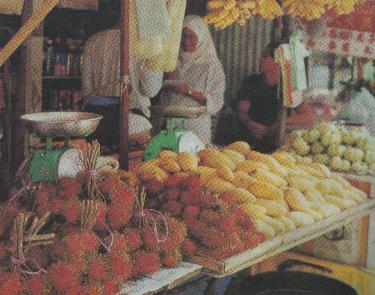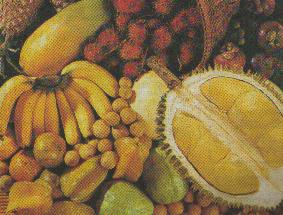

Wherever you travel in Malaysia you are bound to come across some stall that
sells the fruits of the country. The rich Malaysian soil allows for many of
these fruits to grow in abundance and throughout the year. To supplement the
local varieties, imported grapes, kiwi fruit and California apples are found
in supermarkets and other speciality stores.
But if it's Malaysian fruits that you want, the choices are wide indeed. It's
a matter of getting used to the taste, and perhaps even smell. That's the
case with Durian, often called the "king of fruits" by those who love it. But
with the durian, it's love-hate relationship.
For instance, it has a smell that can be "over-powering" to those who are just
introduced to it. It has a thorny appearance and it could hurt if you allowed
it to fall on your foot! It's quite a tricky business getting at the fruit inside,
and the pulp fruit has to be consumed right away as it has a tendency to turn
sour if exposed to the air for some time. Good durians have pulp which are
neither watery nor hard to touch. It's a kind of in-between that's considered
best.

Some say that the durian has aphrodisiac qualities while others will tell
you never to have alcohol with it. There are many myths surrounding this
local delight, but sadly, it's either you like it or hate it!
The Mangosteen on the other hand, is considered to be a choice tropical fruit
and like the durian, native to Malaysia. If the durian is seen as "heaty" then
the mangosteen is "cooling."
Shaped like round berries, the size of tennis balls, it has a thick fibrous
outer layer that is usually maroon in colour. It is easy to open by merely
pressing between the palms. Inside are pure white fleshy segments that are
delicious.
The mangosteen has found new markets as far away as Japan, where it is eaten
more like an ice-cream.

Another local fruit that is highly recommended is the Starfruit, sometimes
called the belimbing. It has a greenish to yellow colour, appears
translucent and has a star-like shape, with a refreshing taste.
It can be eaten fresh, or chilled or you can have it blended as drink. It is
even used as a decoration for cake. The fruit is said to be rich in Vitamin C
and A. Other claims state that it has the properties to lower blood-pressure.

There are efforts now to make the fruit an internationally accepted one since
it remains fresh for up to nine weeks if stored in a constant temperature.
Presently a large quantity of the starfruits found in the European market comes
from Malaysia. This fruit that was considered a "backyard fruit" not so long
ago, has suddenly found new outlets and accounts for about 15 percent all
Malaysian fruits exported.

Twice a year, its the Rambutan season, the egg-shaped fruit that has a reddish,
yellowish or a combination of colours as its outer skin. The skin and seed
are discarded, but the flesh is usually white, sweet and juicy.
The rambutan is a native fruit tree and has been grown in the region for some
time now. Many families have rambutan trees growing in their backyard and
when in season, its a time for great feasting especially with the young.

The Papaya is a fruit that has its origins in South America, but the tree has
grown well in this region and is almost considered "native". The local fruit
is noted for its flavour and the flesh is usually orange to reddish in colour.
The fruit can be eaten fresh or chilled, just add a squeeze of lime or lemon
for added taste.
The Ciku is also the native to South America but extremely popular in the
country. The outer skin is brownish usually, while the flesh inside is
granular. Its taste is said to be delicate, unusual even, because it seems
to have the flavours of several fruits.


The Pineapple is known locally as nenas. There are two commercial
varieties in the country, those for canning which is known as nenas merah
or nenas hijau, and those mean for eating raw, the nenas Sarawak
and nenas Moris. The nenas Sarawak is usually medium in size
with pale yellow flesh. The nenas Moris is usually smaller with a
bright yellow flesh. Both these varieties are sweet and served as dessert
in many places.
Whatever local fruit you get your hands on, you are sure to enjoy yourself,
for Malaysians are great fruit eaters, even the young are taught early to
appreciate this values.